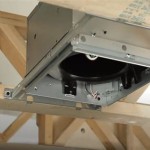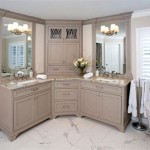Do Bathroom Vents Go Outside?
Bathroom vents play a crucial role in maintaining indoor air quality and preventing moisture-related problems. The question of whether these vents should vent outdoors is often raised, and the definitive answer is generally yes. Venting bathroom exhaust directly outside is considered best practice in building construction and is often mandated by building codes.
Venting bathroom exhaust outside serves the primary purpose of expelling excess moisture generated from showers, baths, and other water usage. This moisture, if not properly vented, can contribute to a variety of issues, including the growth of mold and mildew. Mold and mildew can not only damage building materials like drywall and wood but also pose significant health risks to occupants, particularly those with allergies or respiratory sensitivities.
In addition to moisture removal, bathroom vents also help eliminate unpleasant odors. These odors, often containing volatile organic compounds (VOCs), can linger in the bathroom and permeate other areas of the home if not properly ventilated. External venting ensures these odors are effectively expelled from the living space, contributing to a fresher and healthier indoor environment.
Venting bathroom exhaust into an attic or other enclosed space within the building structure is highly discouraged and often against building codes. While it might seem like a simpler or less expensive option, it can have detrimental consequences. Releasing moisture into an attic can lead to wood rot, insulation degradation, and the potential for mold growth in these concealed areas, creating hidden problems that can be costly and difficult to remediate.
The mechanics of proper bathroom venting involve a system of ductwork that connects the exhaust fan to an exterior vent. This ductwork should be properly sized and installed to ensure efficient airflow. The use of smooth-walled ducts, such as PVC or metal, is generally recommended over flexible ducts, as they minimize airflow resistance and the accumulation of debris. Proper insulation around the ductwork, especially in unconditioned spaces like attics, can prevent condensation and further reduce the risk of moisture-related problems.
Building codes typically specify requirements for bathroom ventilation, including the minimum airflow capacity of the exhaust fan, measured in cubic feet per minute (CFM), and the proper termination of the vent ductwork. It is crucial to consult local building codes and obtain necessary permits before undertaking any bathroom ventilation projects. Compliance with these codes ensures the safety and efficacy of the ventilation system.
Several signs can indicate a problem with a bathroom vent system. These include visible mold or mildew growth in the bathroom, persistent musty odors, peeling paint or wallpaper, and excessive condensation on windows or mirrors. If any of these signs are present, it is essential to inspect the ventilation system to identify and address the underlying issue. This might involve cleaning or replacing the exhaust fan, repairing or replacing damaged ductwork, or ensuring the vent terminates properly outside the building.
Different types of bathroom exhaust fans are available, each with varying features and capabilities. Some fans are equipped with humidity sensors that automatically activate when the humidity level in the bathroom reaches a certain threshold. Others incorporate timers that allow for controlled ventilation periods. Choosing the right type of fan depends on individual needs and preferences, as well as the specific characteristics of the bathroom.
Proper termination of the vent ductwork is critical to the effectiveness of the entire ventilation system. The vent should terminate outside the building, typically through the roof or a sidewall. Using appropriate vent caps and covers prevents pests and debris from entering the ductwork while ensuring proper airflow. It is important to avoid terminating the vent near intake vents for other building systems, such as HVAC systems, to prevent the recirculation of exhausted air.
Maintaining the bathroom vent system is essential for optimal performance. Regular cleaning of the exhaust fan grill and blades can remove dust and debris that can impede airflow. Inspecting the ductwork for any signs of damage or blockage is also recommended. Proper maintenance can extend the lifespan of the ventilation system and ensure its continued effectiveness in controlling moisture and odors.
While the primary focus of bathroom vents is often moisture control, they also contribute to improved indoor air quality by removing other airborne pollutants. These can include particles from cleaning products, personal care products, and other sources. By effectively exhausting these pollutants, bathroom vents contribute to a healthier and more comfortable indoor environment.
In summary, venting bathroom exhaust outside is a crucial aspect of building design and maintenance, contributing significantly to moisture control, odor elimination, and overall indoor air quality. Adhering to building codes and best practices ensures the effectiveness and longevity of the ventilation system, safeguarding the health and well-being of building occupants.

Where Do Bathroom Vents Go Lopco Contracting Ri

Venting A Bath Fan In Cold Climate Fine Homebuilding

Inspecting The Bathroom Exhaust Internachi

Blog

Installing A Bathroom Fan Fine Homebuilding

Is Your Bathroom Exhaust Fan Working Efficiently Multi Trade Building Services

Why Vent Your Exhaust Fan Outside Learn More In Our Blog Post Lifetime Quality Posted On The Topic Linkedin

How To Replace And Install A Bathroom Exhaust Fan From Start Finish For Beginners Easy Diy

Inspecting For Air Sealing At Kitchen And Bathroom Exhaust Fans Internachi

Inspecting For Air Sealing At Kitchen And Bathroom Exhaust Fans Internachi







